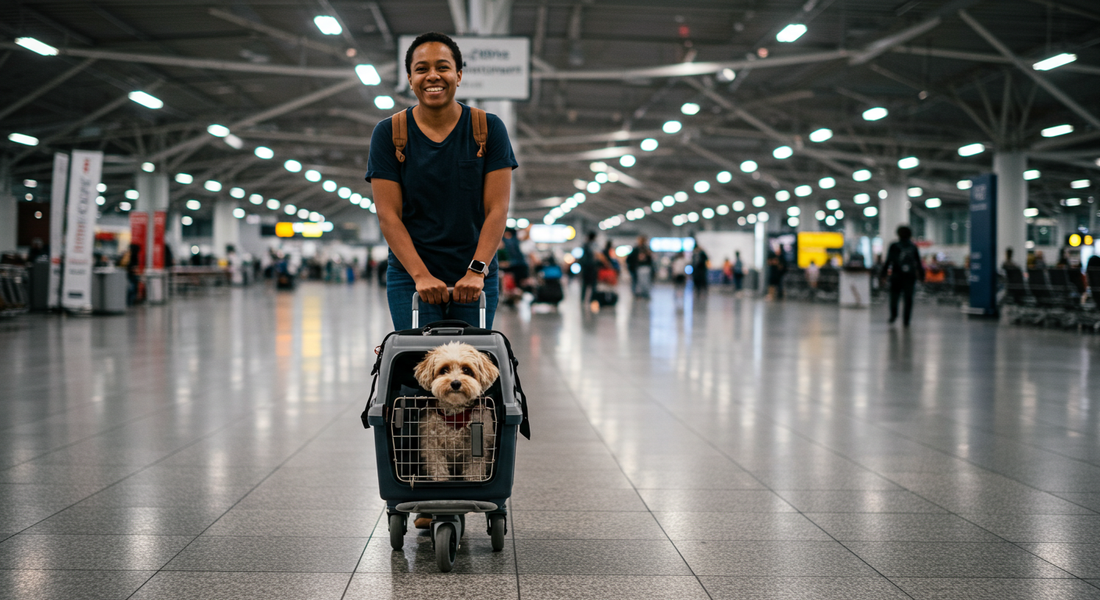
How to Choose the Best Airline-Approved Pet Carrier for Your Dog
Share
Introduction
Flying with your dog can be a smooth and safe experience—if you have the right airline-approved pet carrier. Whether it's a short domestic flight or a long international journey, the carrier you choose directly impacts your dog’s safety, comfort, and stress levels. Not all pet carriers are equal, and airline regulations can vary significantly, making it essential to choose wisely. In this guide, we’ll explore everything you need to consider when selecting the best carrier for air travel with your dog, from airline policies and sizing to comfort features and safety standards.
Understanding Airline Requirements
Before purchasing a carrier, the first step is to check the requirements of the specific airline you’ll be flying with. While many carriers follow similar standards, there are important differences in dimensions, materials, and how the carrier must fit under the seat in front of you.
Most airlines allow small dogs to travel in-cabin if they are in an approved soft-sided or hard-sided carrier that meets size restrictions—commonly around 17–18 inches long, 11 inches wide, and 11 inches tall. However, this varies slightly by airline and aircraft type. Some airlines also have weight limits for the combined dog and carrier (typically around 20 pounds).
Look for carriers that are explicitly labeled as airline-approved or IATA-compliant (International Air Transport Association), especially if you’re planning international travel.
Types of Dog Carriers for Air Travel
1. Soft-Sided Carriers
Soft-sided carriers are the most commonly accepted for in-cabin travel. They are flexible enough to fit under most airline seats and are generally more comfortable for dogs due to their cushioned interiors. Look for carriers with:
- Mesh ventilation on multiple sides
- Collapsible sides for seat fit
- A sturdy, padded bottom
- Zipper security and leash tether inside
Ideal for small breeds and short- to medium-duration flights, soft-sided carriers are also easier to carry and store when not in use.
2. Hard-Sided Carriers
More common in cargo travel, hard-sided carriers are sometimes accepted in-cabin, depending on their size. They offer greater protection from impact and more rigid structure. However, they tend to be heavier and less flexible, which may create fitting issues under seats. Choose these if your dog needs more containment or if your route includes multiple transfers.
Key Features to Prioritize
When choosing a pet carrier, consider these features carefully:
Proper Sizing
The carrier should be large enough for your dog to stand, turn around, and lie down comfortably. Measure your dog’s height (from floor to shoulder) and length (from nose to base of tail) before choosing a size. Avoid oversized carriers—airlines may refuse boarding, and excess space may increase injury risk during turbulence.
Comfort and Padding
A soft, removable base pad or mattress is essential for long flights. It should be washable and non-slip. Interior space should be cozy but not cramped, with rounded edges to avoid injury. Some models include privacy flaps to reduce visual stress.
Ventilation
Look for carriers with mesh panels on at least three sides to ensure airflow. Ventilation is critical to prevent overheating and to comply with most airline regulations.
Secure Closures
Zippers must be strong and ideally lockable or have snap covers to prevent escape. Some carriers come with leash clips inside to keep the dog securely tethered while the bag is open.
Portability
Features like shoulder straps, luggage sleeves, or wheels can ease airport transit. Choose a style that aligns with your travel plans—wheeled for long layovers, backpack-style for hands-free boarding, or tote-style for minimal fuss.
Durability
Strong stitching, reinforced handles, waterproof materials, and chew-resistant fabric help ensure longevity. While you may only fly occasionally, quality gear like this also works for road trips and vet visits.
Preparing Your Dog for Air Travel
A great carrier means little if your dog isn’t comfortable in it. Preparation is key.
- Begin crate training weeks before the flight, using the carrier during naps or car rides.
- Place familiar items like a small blanket or toy inside.
- Practice zipping the door closed for short periods while rewarding calm behavior.
- Use calming sprays or chews (veterinarian-approved) if your dog has travel anxiety.
Familiarity with the carrier builds trust and reduces stress during the flight.
Additional Travel Accessories to Include
While the carrier is the main item, a few add-ons can make travel smoother:
- Absorbent liner or training pad in case of accidents
- Collapsible water bowl
- Health certificate and vaccination records (especially for international flights)
- ID tag or luggage label with pet and owner info
- Lightweight blanket or shirt with your scent for comfort
For those traveling with Snuggle&Go, many soft-sided carriers come with matching travel kits that include bowls, wipes, and even collapsible playpens for use at your destination.
Common Mistakes to Avoid
- Not checking airline policy: Every airline differs. Some require advance booking for pets, charge pet fees, or limit the number of animals per flight.
- Oversized carrier: If it doesn’t fit under the seat, you may be forced to check your dog—potentially against your wishes.
- Last-minute purchase: Carriers need to be broken in. Dogs need time to adjust. Buying too close to travel can cause unnecessary anxiety.
- Lack of ID: Label the carrier clearly. In case of emergency, contact info can be a lifesaver.
- Ignoring comfort: A carrier that meets regulations but lacks padding or ventilation can cause distress, especially during delays.
Conclusion
Choosing the right airline-approved pet carrier is more than just meeting size requirements—it's about creating a safe, comfortable, and familiar space for your dog in a stressful environment. Soft-sided carriers remain the most versatile option for in-cabin travel, but each dog’s size, temperament, and the airline’s policies should guide your decision.
Invest in a high-quality carrier that combines safety, durability, and thoughtful design, and begin the acclimation process early. With careful planning and the right tools, air travel can be a positive experience for you and your furry companion.

